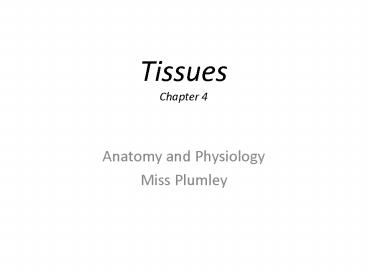Tissues Chapter 4 PowerPoint PPT Presentation
Title: Tissues Chapter 4
1
TissuesChapter 4
- Anatomy and Physiology
- Miss Plumley
2
What is human tissue?
- Tissue
- Cells organized into groups and layers
- Each type of tissue is composed of similar cells
specialized to carry on a particular function
3
Four Major Types of Tissue
- Epithelial
- Protective coverings, also used for absorption
and secretion - Connective
- Support soft body parts and bind structures
together - Muscle
- Produces body movements
- Nervous
- Conducts impulses that help control and
coordinate body activities - Extracellular matrix Nonliving portion of
tissue
4
Epithelial Tissues
- -Found through out the body
- -cover organs, forms inner lining of body
cavities, lines hollow organs - -always exposed to the outside or open internal
space - Basement Membrane
- Nonliving layer that is found between the
underside of epithelial tissue and connective
tissue (basement membrane is part of the
extracellular matrix)
5
Epithelial Tissue
- -Tightly Packed
- -Readily Divide
- Injuries can heal quickly and new cells replace
lost or damaged ones - -Lack Red Blood Vessels
- Receive nutrients from underlying connective
tissue - Classified according to shape and number of cell
layers - 1. Squamous Thin, flat cells
- 2. Cuboidal Cubed-shaped cells
- 3. Columnar Elongated Cells
- 4. Simple single layer
- 5. Stratified two or more layers
6
Epithelial Tissue
- There are 9 Types of Epithelial Tissue
- 1. Simple Squamous
- Single layer, thin, flattened cells
- site where diffusion and filtration take place
- Example
- They line the air sacs of the lungs where oxygen
and carbon dioxide are exchanged. - Forms the walls of capillaries
- Lines the inside of blood and lymph vessels
- Covers membranes that line body cavities
- Tissue is easily damaged because it is so thin
7
Epithelial Tissue
- 2. Simple Cuboidal Epithelium
- Single layer of cube-shaped cells
- Central located spherical nuclei
- Covers ovaries
- Lines ducts of certain glands
- Salivary glands, thyroid gland
- Secretes glandular products
- Lines most of kidney tubules
- -Example Functions in secretion and absorption
8
Epithelial Tissue
- 3. Simple Columnar Epithelium
- Elongated cells
- Single layer where nuclei is found near basement
membrane - Nonciliated Cells
- Lines uterus
- Lines most organs of the digestive tract,
including the stomach and small intestine - Example Secretes digestive fluids and absorbs
nutrients from digested food - Ciliated Cells
- Help moving egg cells to uterus in the
reproductive tubes of females
9
Epithelial Tissue
- 4. Pseudostratified Columnar Epithelium
- Stratified or layered cells
- Lines passage of respiratory system
- Ciliated
- Mucus covered
- Trap dust and move it out of the airways
10
Epithelial Tissue
- 5. Stratified Squamous Epithelium
- Thick tissue
- Lines oral cavity, esophagus, vagina and anal
canal - Example A protein called KERATIN is not formed
keeping these areas soft and moist - Forms outer layer of skin (epidermis)
- Example As skin cells age they accumulate
KERATIN and then harden and die producing dry,
tough skin
11
Epithelial Tissue
- 6. Stratified Cuboidal Epithelial
- Two or more layers of cubed-shaped cells
- Linings of salivary gland and mammary gland ducts
12
Epithelial Tissue
- 7. Stratified Columnar Epithelium
- Several cell layers
- Protection and Secretion
- Example
- Part of male urethra, Vas deferens and part of
the pharynx
13
Epithelial Tissue
- 8. Transitional Epithelium
- Prevent contents of the urinary tract from
diffusing back into the internal enviornment - Change response to increase tension
- Expandable lining
14
Epithelial Tissue
- 9. Glandular Epithelium
- Secrete substances into ducts or into body fluids
- Example
- Salivary glands, sweat glands and endocrine glands
15
Epithelial Tissue
- Epithelial Tissue Assignment
- Create a Foldable
- Include all 9 types of Epithelial Tissue
- Description and picture is required for each type
of Epithelial Tissue - Explain where each type of tissue can be found in
the human body - Include the function of each tissue
- Pictures can be drawn or printed from the
internet - Complete work cited on the back of your foldable
if necessary

